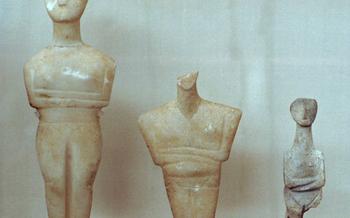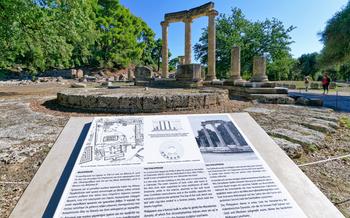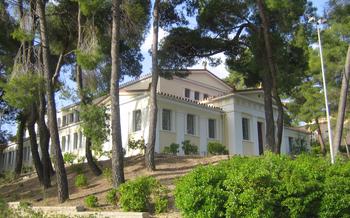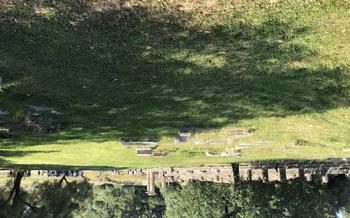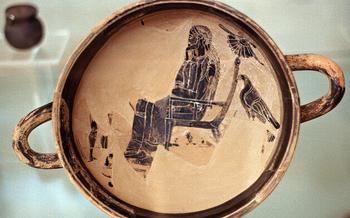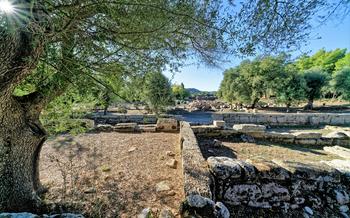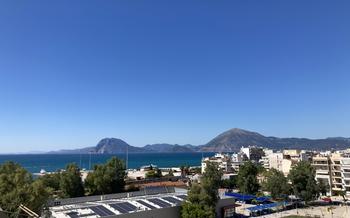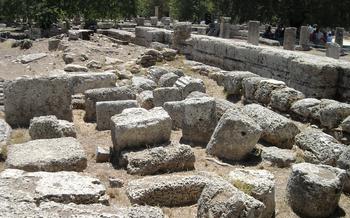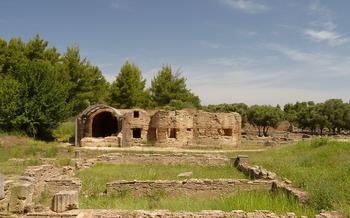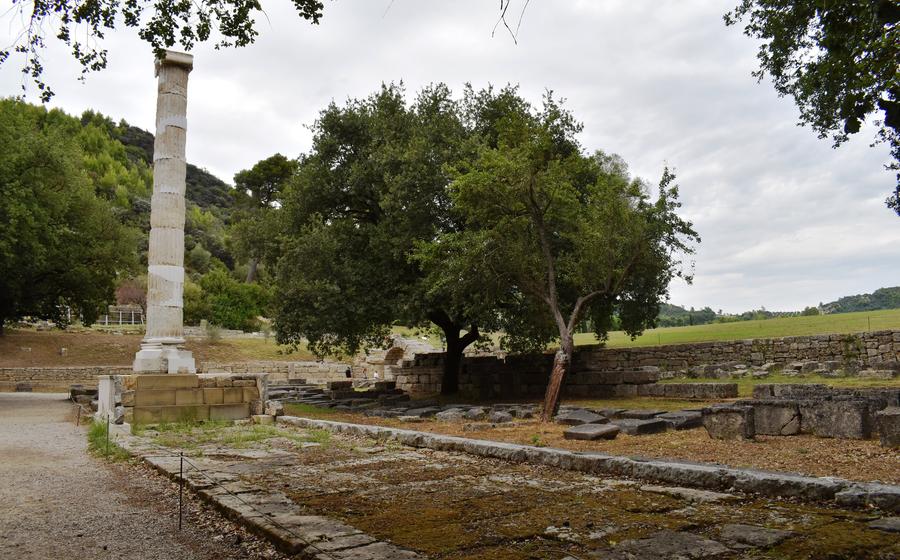
Archaeological Site of Olympia
- A Journey to Ancient Glory: Unveiling Olympia's Storied Past
- A Stroll Through Time: Exploring the Archaeological Site
- Witnessing Athletic Prowess: The Ancient Olympic Games
- Echoes of Triumph: The Museum of Olympia
- In the Footsteps of Champions: The Olympic Stadium
- Honoring the Gods: The Temple of Zeus
- A Royal Sanctuary: The Philippeion
- Honoring Fallen Heroes: The Pelopion
- Craftsmanship and Commerce: The Workshops
- A Sacred Spring: The Kladeos River
- Connect with History: Educational Programs and Guided Tours
- Planning Your Visit: Essential Information
- Insider Tip: Unveiling Hidden Gems
A Journey to Ancient Glory: Unveiling Olympia's Storied Past
Olympia, nestled in the picturesque valley of the Peloponnese, is a place where history and myth intertwine, where the echoes of ancient athletic triumphs still reverberate. As the birthplace of the Olympic Games, Olympia holds a profound significance in the annals of human history. Archaeological excavations have unearthed the grandeur of this ancient sporting sanctuary, revealing the stadiums, temples, and workshops that once hosted the most celebrated athletic competitions of the ancient world.
Legends abound in Olympia, weaving a tapestry of tales that add to its mystique. Hercules, the mighty son of Zeus, is said to have competed in the first Olympic Games, establishing a legacy of strength and prowess that would echo through the ages. The site is steeped in mythology, where gods and heroes walked among mortals, shaping the destiny of this sacred place.
A Stroll Through Time: Exploring the Archaeological Site
Olympia, the birthplace of the Olympic Games, invites you on a captivating journey through its ancient ruins. The archaeological site, spanning over 50 hectares, is a treasure trove of well-preserved monuments that offer a glimpse into the grandeur of ancient Greece.
As you step through the entrance, the sprawling layout of the site unfolds before you. Divided into several zones, each dedicated to a specific purpose, Olympia reveals its rich history and diverse functions. The heart of the site is undoubtedly the stadium, where athletes from across the Hellenic world competed for glory in the Olympic Games. The well-preserved starting line and finish line evoke a sense of awe as you imagine the anticipation and excitement that filled the air during these legendary events.
Among the numerous highlights of Olympia, the Temple of Zeus stands as a testament to the architectural prowess of the ancient Greeks. Dedicated to the king of the gods, this colossal temple once housed one of the Seven Wonders of the Ancient World – the awe-inspiring statue of Zeus by the renowned sculptor Phidias. Though the statue no longer exists, the sheer size and grandeur of the temple leave a lasting impression.
Another notable structure is the Philippeion, a circular building erected by Philip II of Macedon. With its elegant Ionic columns and intricate sculptures, the Philippeion is a testament to the power and influence of the Macedonian dynasty. The building once housed statues of the royal family, further emphasizing the political significance of Olympia.
As you continue your exploration, you'll encounter the Pelopion, a heroon dedicated to Pelops, the mythical king of Elis. This impressive structure, adorned with sculptures depicting scenes from Greek mythology, offers insights into the religious beliefs and hero cults of ancient Greece.
Beyond the temples and sanctuaries, Olympia was also home to bustling workshops that produced a variety of goods, including pottery, metalwork, and textiles. These workshops played a crucial role in supporting the Olympic Games and the daily life of the city's inhabitants.
A visit to the archaeological site of Olympia is a journey through time, allowing you to step back into the world of ancient Greece and experience the grandeur of the Olympic Games. As you wander among the ruins, you'll gain a deeper appreciation for the achievements of this remarkable civilization and the legacy that continues to inspire us today.
Witnessing Athletic Prowess: The Ancient Olympic Games
The ancient Olympic Games, held every four years in Olympia, were not just sporting competitions but sacred festivals deeply intertwined with Greek mythology and religious beliefs. They originated as local competitions dedicated to Zeus, the king of the gods, but gradually evolved into panhellenic events, attracting athletes and spectators from across the Greek world.
The games featured a variety of athletic competitions, ranging from footraces of various distances to wrestling, boxing, and chariot racing. Each event held deep symbolic meaning, testing the physical prowess, courage, and determination of the participants. The most prestigious event was the stadion race, a sprint of approximately 192 meters, which gave rise to the term "stadium" still used today.
Rituals and traditions played a significant role in the games. Before the competitions, a sacred truce, known as the ekecheiria, was declared, ensuring peace and safe passage for athletes and spectators traveling to Olympia. The games began with a grand procession, led by priests and officials, carrying offerings to Zeus and other deities. Athletes competed naked, symbolizing purity and equality, and swore an oath to abide by the rules and compete fairly.
Victors in each event were crowned with a wreath of wild olive leaves, cut from a sacred tree near the Temple of Zeus. This simple yet symbolic gesture represented the highest honor and glory that an athlete could achieve. Their names were recorded and celebrated in victory odes composed by poets and performed at festivals throughout Greece.
The Olympic Games were more than just competitions; they were a celebration of human achievement, a showcase of Greek culture, and a symbol of unity among the diverse city-states of ancient Greece. The legacy of these games lives on today, inspiring modern Olympic competitions and reminding us of the enduring power of sports to bring people together and foster a spirit of excellence and camaraderie.
Echoes of Triumph: The Museum of Olympia
Enrich your understanding of the ancient Olympic Games and Greek sportsmanship by delving into the treasures housed within the Museum of Olympia. This remarkable institution serves as a guardian of precious artifacts that bring to life the grandeur and spectacle of the ancient sporting events.
Among the museum's highlights is the awe-inspiring statue of Hermes by Praxiteles, a masterpiece of classical Greek sculpture that captures the essence of the messenger god with its graceful poise and intricate details. Another must-see is the Nike of Paionios, a stunning bronze sculpture depicting the goddess of victory in mid-flight, her wings outstretched as if about to alight upon the victor's brow.
Beyond these iconic works, the museum showcases a wealth of other artifacts that provide valuable insights into the world of ancient Greek athletics. From intricately decorated oil flasks used by athletes to anoint their bodies to the sturdy discuses and javelins that tested their strength and precision, each artifact tells a story of athleticism, competition, and the pursuit of excellence.
In the Footsteps of Champions: The Olympic Stadium
Amidst the ruins of Olympia, the ancient Olympic Stadium stands as a testament to the athletic prowess and competitive spirit that defined the Olympic Games. Constructed in the 5th century BC, this impressive arena could accommodate up to 45,000 spectators, who would gather to witness the spectacle of the games.
The stadium is a testament to ancient Greek engineering and design. Its elongated shape, measuring approximately 212 meters in length and 30 meters in width, provided an optimal viewing experience for all attendees. The gently sloping terraces, divided into 30 rows, ensured that everyone had a clear line of sight to the action unfolding on the sandy track below.
The starting line, marked by a row of white limestone blocks, is a tangible reminder of the intense anticipation and excitement that filled the air as athletes prepared to launch into their races. The finish line, located at the opposite end of the stadium, represented the culmination of their efforts and the realization of their Olympic dreams.
Standing in this hallowed arena, one can almost hear the roar of the crowd as they cheered on their favored athletes. The stadium's atmosphere is palpable, transporting visitors back in time to an era when sporting excellence was celebrated and the pursuit of victory was considered a sacred endeavor.
Honoring the Gods: The Temple of Zeus
Among the awe-inspiring structures of Olympia, the Temple of Zeus stands as a testament to the grandeur of ancient Greek architecture and the devotion to the king of the gods. Constructed in the 5th century BC, this colossal temple symbolized the power and majesty of Zeus, the supreme deity of the Greek pantheon.
The temple's sheer size is staggering, stretching over 66 meters in length and 27 meters in width. Its massive columns, each standing over 10 meters tall, exude an aura of strength and stability. The pediments, or triangular gables at each end of the temple, were adorned with intricate sculptures depicting the legendary battles between the gods and the giants, as well as the mythical exploits of Hercules.
Inside the temple stood a colossal statue of Zeus, crafted from ivory and gold by the renowned sculptor Phidias. This awe-inspiring masterpiece, considered one of the Seven Wonders of the Ancient World, portrayed Zeus seated on his throne, his powerful physique radiating divine authority. The statue's eyes were inlaid with precious stones, reflecting the sunlight and creating an almost lifelike presence.
The Temple of Zeus was not merely a place of worship but also a site for grand religious festivals and ceremonies. During the Olympic Games, processions of athletes, priests, and officials would converge at the temple to honor Zeus and seek his blessings for victory. The temple's interior was adorned with rich tapestries, offerings, and dedications from victorious athletes, creating a sense of sacredness and devotion.
Sadly, the temple's grandeur did not withstand the ravages of time. It was destroyed by fire in the 5th century AD, and the colossal statue of Zeus was lost forever. Despite its ruined state, the Temple of Zeus remains an enduring symbol of ancient Greek religious fervor and artistic prowess, inspiring awe and wonder in visitors to this sacred site.
A Royal Sanctuary: The Philippeion
History and Significance
Erected in the heart of Olympia, the Philippeion stands as a testament to the grandeur and power of the ancient Macedonian kingdom. Commissioned by Philip II, the father of Alexander the Great, this circular structure served as a tribute to his lineage and military achievements. The Philippeion embodied the political and cultural aspirations of the Macedonians, seeking to assert their dominance in the Greek world.
Circular Design and Ionic Columns
The Philippeion's unique circular design set it apart from the predominantly rectangular temples of Olympia. Its colonnade of 18 slender Ionic columns supported an elegant entablature, creating a harmonious and graceful silhouette. The columns, adorned with intricate fluting, conveyed a sense of lightness and elegance, reflecting the refined aesthetic sensibilities of the Macedonian court.
Statues and Sculptures
The interior of the Philippeion was adorned with a series of statues, each holding symbolic significance. In the center stood a colossal statue of Zeus, the king of the gods, flanked by statues of Philip II and his family members. These sculptures served to glorify the Macedonian dynasty and their connection to the divine. The Philippeion's exterior was further embellished with intricate sculptures depicting scenes from Greek mythology and Macedonian history, adding to the building's overall grandeur.
Honoring Fallen Heroes: The Pelopion
A Sacred Tribute to a Legendary King
Among the many sacred structures that grace the archaeological site of Olympia, the Pelopion holds a unique place. This impressive heroon, or hero's shrine, was erected in honor of Pelops, the mythical founder and king of Elis, whose name is inextricably linked to the origins of the Olympic Games.
Pelops, a figure shrouded in myth and legend, is said to have arrived in Elis from Lydia, bringing with him both wealth and wisdom. Through his prowess and cunning, he won the hand of Hippodamia, the daughter of King Oenomaus, and thus gained the throne of Elis.
To honor his adopted homeland and perpetuate his legacy, Pelops is believed to have established the Olympic Games, which were initially held as a funeral competition in his memory. The Pelopion, constructed in the 6th century BCE, served as a lasting tribute to this legendary king and a tangible reminder of his enduring influence on Olympia and the Olympic tradition.
Architectural Symbolism and Sacred Rituals
The Pelopion is a remarkable example of ancient Greek architecture, showcasing a distinctive circular form that sets it apart from other structures at Olympia. Its circular design is believed to symbolize the cyclical nature of life and death, echoing the hero's journey from the realm of the living to the realm of the dead.
Within the Pelopion, a series of altars and stelae were arranged, serving as focal points for religious rituals and offerings. These rituals were believed to honor Pelops and other heroes associated with the Olympic Games, ensuring their continued favor and protection.
A Legacy that Endures
The Pelopion stands as a testament to the enduring legacy of Pelops and the profound reverence with which he was held by the ancient Greeks. As visitors explore this sacred site, they are transported back in time, connecting with the mythical origins of the Olympic Games and honoring the heroes who shaped this iconic tradition.
Craftsmanship and Commerce: The Workshops
Olympia was not just a place of athletic competition; it was also a thriving hub of commerce and craftsmanship. Skilled artisans from across Greece gathered here to produce a wide range of goods, from pottery and metalwork to textiles and sculptures.
The workshops were located in the northern part of the sanctuary, near the Kladeos River. This strategic location provided easy access to water for various industrial processes, such as metalworking and pottery. The workshops were also close to the stadium and other sporting venues, ensuring a steady stream of customers.
Archaeological excavations have revealed the remains of several workshops, including a pottery workshop, a metalworking workshop, and a woodworking workshop. These workshops were typically small, one-room structures with simple tools and equipment. However, the quality of the goods produced in these workshops was exceptional.
The pottery workshop produced a wide range of ceramic vessels, from simple cooking pots to elaborate painted vases. The metalworking workshop produced bronze and iron tools, weapons, and armor. The woodworking workshop produced furniture, chariots, and other wooden objects.
The goods produced in the workshops of Olympia were not just for local consumption. They were also exported to other parts of Greece and beyond. The Olympic Games provided a unique opportunity for artisans to showcase their skills and products to a wide audience.
The workshops of Olympia played a vital role in the economy of the sanctuary. They provided employment for skilled artisans and generated revenue for the city of Elis. They also contributed to the spread of Greek culture and technology throughout the ancient world.
A Sacred Spring: The Kladeos River
Flowing through the heart of Olympia, the Kladeos River holds a deep significance in ancient Greek mythology and rituals. Considered a sacred spring, its waters were believed to possess purifying and healing properties. Athletes preparing for the Olympic Games would immerse themselves in the river to cleanse their bodies and minds before competing. The Kladeos also played a central role in the religious ceremonies associated with the games. During the festival of Zeus, processions and rituals were held along the riverbank, invoking the god's blessings and seeking his favor.
Beyond its religious significance, the Kladeos River was a vital source of water for the inhabitants of Olympia. The ancient Greeks constructed an elaborate system of aqueducts and channels to divert water from the river to irrigate their fields and supply their homes. The river's fertile banks provided rich soil for agriculture, allowing the local population to cultivate crops and sustain their community.
Today, visitors to Olympia can still experience the beauty and tranquility of the Kladeos River. Its crystal-clear waters meander through the archaeological site, creating a serene and picturesque landscape. Take a moment to pause along the riverbank, immerse your feet in the cool water, and let your imagination transport you back to the days when ancient athletes and pilgrims sought purification and renewal in this sacred spring.
Connect with History: Educational Programs and Guided Tours
Olympia's rich history and significance come alive through the various educational programs and guided tours offered to visitors. These programs are designed to enhance your experience, providing expert insights and historical context that bring the ancient site to life.
Enrich your visit by joining a guided tour led by knowledgeable professionals who share their passion for ancient Greece. These tours delve into the history of the Olympic Games, the mythology surrounding Olympia, and the architectural marvels that adorn the site. You'll gain a deeper understanding of the ancient sporting events, the rituals and traditions associated with them, and the religious beliefs that shaped Olympia's sacred landscape.
Educational programs are also available for groups and individuals seeking a more immersive experience. These programs offer hands-on activities, workshops, and lectures that explore various aspects of ancient Greek culture, art, and archaeology. Participate in pottery classes, learn about ancient Greek mythology, or engage in discussions on the history of the Olympic Games.
To make the most of your visit, consider booking a guided tour or educational program in advance. Choose a tour that aligns with your interests and allows ample time for exploration. Embrace the opportunity to connect with history and gain a profound appreciation for the enduring legacy of Olympia.
Planning Your Visit: Essential Information
A journey to Olympia requires careful planning to ensure a smooth and enriching experience. Whether you're arriving by car, bus, or train, transportation to Olympia is convenient and accessible. Once you're in the town, a range of accommodation options awaits, from budget-friendly hostels to luxurious hotels. For a truly immersive experience, consider staying in a traditional Greek guesthouse, where you can savor local hospitality and cuisine.
When planning your itinerary, allocate ample time to explore the archaeological site and the museum. Allow at least three to four hours to wander through the ruins, marvel at the ancient structures, and delve into the history of the Olympic Games. The museum, with its impressive collection of artifacts, deserves at least an hour of your attention.
To enhance your visit, consider joining a guided tour. Led by knowledgeable experts, these tours provide fascinating insights into the site's history, mythology, and significance. They'll point out hidden details and share stories that bring the ancient world to life. Choose a tour that aligns with your interests and pace, whether it's a comprehensive overview or a focused exploration of a specific area.
Olympia offers more than just ancient ruins. Take advantage of the opportunity to explore the surrounding area. The picturesque village of Ancient Olympia, located just a short walk from the site, offers a glimpse into traditional Greek life. Visit local tavernas to savor delicious regional dishes, and don't miss the opportunity to shop for unique souvenirs and handicrafts.
With its rich history, stunning scenery, and warm hospitality, Olympia promises an unforgettable experience. Immerse yourself in the birthplace of the Olympic Games, and let the spirit of ancient Greece captivate your imagination.
Insider Tip: Unveiling Hidden Gems
Beyond the main attractions of the archaeological site, Olympia offers a treasure trove of hidden gems waiting to be discovered. For those seeking a deeper connection with ancient history, the Leonidaion and the Bouleuterion stand as architectural marvels that transport visitors back in time. The Leonidaion, once a lavish guesthouse for distinguished visitors, boasts intricate mosaics and well-preserved columns, offering a glimpse into the opulence of ancient Greek hospitality. The Bouleuterion, where the city council convened, showcases impressive acoustics and provides insights into the political processes of the era.
Venturing beyond the archaeological site, nature enthusiasts can embark on scenic hiking trails that weave through the enchanting surroundings of Olympia. The lush greenery, fragrant wildflowers, and panoramic views of the valley create a serene and invigorating experience. These trails offer a unique perspective on the region's natural beauty and provide opportunities for exploration and tranquility.
To fully immerse yourself in the local culture, seek out traditional tavernas and cafes nestled in the heart of Olympia. Savor the flavors of authentic Greek cuisine, indulge in culinary delights such as freshly caught seafood, succulent grilled meats, and delectable pastries. Engage with the friendly locals, learn about their customs, and let the vibrant atmosphere transport you to another time. These culinary and cultural experiences will leave you with lasting memories and a deeper appreciation for the richness of Greek heritage.
